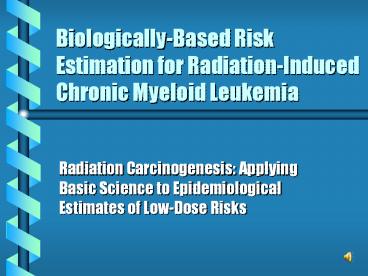Biologically-Based Risk Estimation for Radiation-Induced Chronic Myeloid Leukemia - PowerPoint PPT Presentation
Title:
Biologically-Based Risk Estimation for Radiation-Induced Chronic Myeloid Leukemia
Description:
Radiation Carcinogenesis: Applying Basic Science to Epidemiological Estimates of ... This is a one-stage model of carcinogenesis. where. Likelihood Data ... – PowerPoint PPT presentation
Number of Views:36
Avg rating:3.0/5.0
Title: Biologically-Based Risk Estimation for Radiation-Induced Chronic Myeloid Leukemia
1
Biologically-Based Risk Estimation for
Radiation-Induced Chronic Myeloid Leukemia
- Radiation Carcinogenesis Applying Basic Science
to Epidemiological Estimates of Low-Dose Risks
2
Overview
- Bayesian methods and CML
- Linear-Quadratic-Exponential model
- Likelihood and prior data sets
- Baseline LQE estimate of CML risk
- Improved risk estimates based on BCR-to-ABL
distances and CML target cell numbers - Net lifetime CML risk Can it have a U-shaped
low dose response?
3
Bayesian Methods
- Priors likelihood estimates ? posteriors
- Posterior information equals prior plus
likelihood information - Posterior means are information-weighted averages
of prior and likelihood means - Posteriors are normal if the prior and
likelihood estimates are normal - Priors act as soft constraints on the parameters
- Priors and structures come from the same data
4
Chronic Myeloid Leukemia
- CML is homogeneous, prevalent, radiation-induced,
and caused by BCR-ABL - The a2 intron of ABL is unusually large
- Leukemic endpoints have rapid kinetics
- White blood cells need fewer stages
- Linear CML risk is not biologically-based
- Linear-quadratic-exponential CML risk does have
a biological basis
5
(No Transcript)
6
Linear Risk Model
Using the BCR-ABL to CML waiting time density
and the linear model
we maximized the log-likelihood
7
Linear-Quadratic-Exponential Model
The LQE model is
where
D?i and Dni are the gamma and neutron doses in
gray
N is the number of CML target cells per adult
P(baT) is the probability of BCR-ABL given a
translocation
This is a one-stage model of carcinogenesis.
8
Likelihood Data
- CML is practically absent in Nagasaki
- High dose HF waiting times are too long
- HM data is consistent with prior expectations
9
aage at diagnosis bO observed cases (E
expected background cases based on U.S. incidence
rates) ctsx average of the times since exposure
for the cases
10
Prior Data Sources
- C1 and k SEER data
- kt Patients irradiated for BGD
- ?k, ?k and ?kn CAFC and MRA assays
- ?/? and ?n/? Lymphocyte dicentric yields
- C2 Depends on ?, kt, N, and P(baT)
- N SEER and translocation age structure data
- P(baT) BCR and ABL intron sizes, the genome
size
11
(No Transcript)
12
(No Transcript)
13
Parameter Estimates
14
CML Risk Estimates
The lifetime excess CML risk in the limit of low
?-ray doses
yields
- Linear model
- R? 0.0075 Gy-1 and Q? 0.0158 Gy-1
- LQE posterior model
- R? 0.0022 Gy-1 and Q? 0.0042 Gy-1
15
CML Target Cell Numbers
- A comparison of age responses for CML and total
translocations suggests a CML target cell number
of 2x108 - 1012 nucleated marrow cells per adult and one
LTC-IC per 105 marrow cells suggests 107 CML
target cells - P(baT) 2TablTbcr/?2 may not hold
16
BCR-to-ABL 2D distances in lymphocytes
Kozubek et al. (1999) Chromosoma 108 426-435
17
Theory of Dual Radiation Action
P(baD) probability of a BCR-ABL translocation
per G0/G1 cell given a dose D tD(r)dr expected
energy at r given an ionization event at the
origin
intra-track component inter-track
component Sba(r) the BCR-to-ABL distance
probability density g(r) probability that two
DSBs misrejoin if they are created r units
apart Y 0.0058 DSBs per Mb per Gy ? mass
density TBCR 5.8 kbp TABL 300 kbp
18
Estimation of g(r)
?d? in .01, .025, ?dx in .04, .05, ?d
in .05, .06
G35 DSB/Gy per cell 6.25 kev/um3 1 Gy
R 3.7 um ? r0 0.24 ?m, p0 0.06
19
?
20
Dead-Band Control of HSC levels
- Transplant doses of 10, 100, and 1000 CRU gt CRU
levels 1-20 or 15-60 normal Blood (1996) 88
2852-2858 - Broad variation in human HSC levels Stem
Cells (1995) 13 512-516 - Low levels of HSCs in BMT patients
Blood (1998) 91 1959-1965
21
Figure 3 Hypersensitivity ratios in the
literature (left panel) and the log-survival dose
response for T98G human glioma cells (right
panel). Figures from Joiner, M.C., Marples, B.,
Lambin, P., Short, S.C. and Turesson, I.,
Low-dose hypersensitivity current status and
possible mechanisms. Int J Radiat Oncol Biol Phys
(2001) 49 379-389.
22
Net Lifetime CML Risk
The net lifetime excess risk of CML is
Letting Dn 0 while D? ? 0
We solved R0 0 for ?k?s as a function of
exposure age x.
23
(No Transcript)
24
(No Transcript)
25
Conclusions
- Bayesian methods provide a natural framework for
biologically based risk estimation - BCR-to-ABL distance data and knowledge of CML
target cell numbers can be useful in a
biologically based approach to CML risk
estimation - Low dose hypersensitivity to killing might lead
to a U-shaped low dose response if there is a
dead-band in the control of target cell numbers
26
Acknowledgments
- Rainer Sachs
- David Hoel
- NIH and DOE































